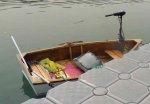Have a Shakespeare Glider 32 trolling motor that is used regularly in the powerboat, transom mounted. Would like to use it my wooden boat, bow mounted. Instead of switching the head around (would need to be done each time I switched boats) could I just reverse the polarity? Today I run a quick test and this worked just fine: reversing the connections to the battery reversed the prop and all speeds worked just fine. A 1 second job contrary to switching the head's direction. Tried calling their customer support line but it's hopeless. They never pick up and I tried more than once. Besides, this is likely a call centre in India or the Philippines that handles dozens of products for different companies, so they'd likely be reading their answers off a generic script anyhow.
So has anyone here tried this with success? As in, not causing any sort of damage. These seem to be just basic electric motors with virtually no electronics involved. But before frying it, figured I asked first.
So has anyone here tried this with success? As in, not causing any sort of damage. These seem to be just basic electric motors with virtually no electronics involved. But before frying it, figured I asked first.




















